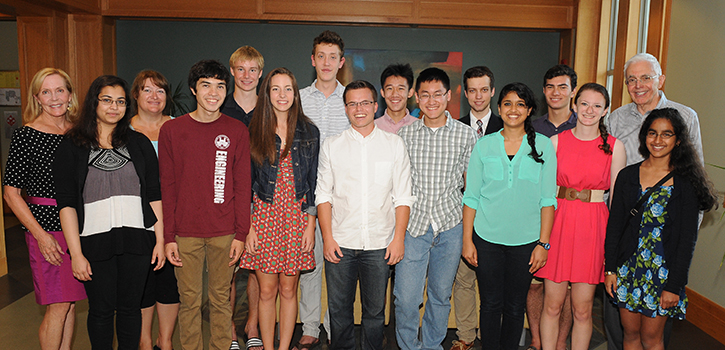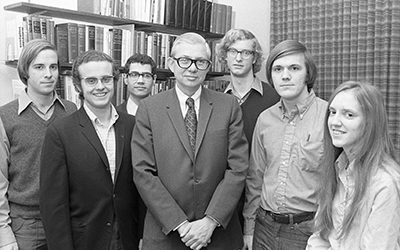Langsdorf Scholars: Building a Family
They are the Langsdorfs — and they are more than 500 strong. They have gone on to successful careers in medicine, law and engineering; in industry, research labs, the military, consulting and higher education, among others

The thread that ties the generations of Langsdorfs together is that they have pursued undergraduate study in the School of Engineering & Applied Science with a Langsdorf Fellowship.
The Alexander S. Langsdorf Fellowships in Engineering are a pioneering merit-based award begun in 1966 by then-Dean James M. McKelvey, PhD, for up to 10 incoming freshmen with high academic potential. He named the program after Langsdorf, a major figure in engineering education at Washington University who was dean of the school from 1910-1920 and again from 1928-1948.
“It was a fellowship with a program wrapped around it,” says David “Dave” Rossetti, who retired as vice president of university relations and research at Cisco and who earned a bachelor’s degree in computer science and applied mathematics in 1974 — the fifth class of Langsdorf students to graduate. He says they were interviewed by and introduced to the existing Fellows, expected to help “shepherd in” the next classes of Langsdorfs and to be part of the “‘society’ of Langsdorfs.”
“We look for top scholars who have already taken on leadership roles, have organized and taken part in successful activities and are looking for ways they can be involved.”
— Lee Anne Quatrano
Langsdorfs: Leading the way
High expectations continue for today’s students in the Langsdorf Scholars Program, says Lee Anne Quatrano, co-adviser to the program with Kim Shilling, assistant dean for engineering student services.
“We look for top scholars who have already taken on leadership roles, have organized and taken part in successful activities and are looking for ways they can be involved,” Quatrano says.
And they certainly are meeting those expectations. Senior Arunita Kar, who is majoring in electrical engineering and applying to graduate schools, started an outreach program for the James M. McKelvey Undergraduate Research scholars — an award she also holds — for which they visit local middle and high schools doing hands-on activities with the students to get them interested in pursuing engineering.
“I’ve always loved physics and math,” she says, “but I wanted to apply those and do something that will help others. I think engineering’s a great skill for that.”
She also is conducting research in nanophotonics in the lab of Lan Yang, PhD, the Das Family Career Development Associate Professor in electrical & systems engineering. “Research is definitely something I want to keep as part of my life,” she says. “It’s the very first step where all the ideas and work go into it before something becomes public and worldwide.”
Research and community service are important, too, to sophomore Ananya Benegal, who is majoring in biomedical engineering. Also a McKelvey Research Scholar, she is working in the lab of Philip Bayly, PhD, department chair and the Lilyan and E. Lisle Hughes Professor of Mechanical Engineering, where the focus is on the biomechanics of traumatic brain injury.
This past summer she spent two weeks in Guatemala with Engineers Without Borders working at Roosevelt Hospital, a poorly funded public hospital that uses old, donated and often broken equipment. Benegal and the other students repaired broken ventilators and other machinery.
Like the other current scholars, Benegal was energized by the first-ever Langsdorf Scholars retreat, which took place at Pere Marquette State Park in Illinois just before fall classes started.
“To continue to build the Langsdorf family, we wanted the new freshman scholars to bond with the present ones,” Quatrano says.
Freshman Sydney Katz says the retreat was a good experience.

“We didn’t really know each other that well coming in, but after we left, we felt like we’d known each other for a really long time,” she says.
Katz remembers being at a sports practice when she got the call from Ralph S. Quatrano, PhD, dean of the School of Engineering & Applied Science, that she had been chosen to receive the Langsdorf scholarship.
She tentatively plans to major in electrical engineering with a minor in aerospace engineering. Her interest in space resulted in two summers as an intern at NASA Glenn Research Center in Cleveland. In 2013, she worked in a chemistry lab developing high-temperature materials, and in 2014, she was part of a COMFORT team, which develops new designs for a satellite or rover. She says her “dream job” would be to work at Mission Control in Houston or in the project to send humans to Mars.
For sophomore Maxwell Wang, the best part of being in the program is getting to know the other Langsdorf Scholars, as well as learning from Langsdorf alumni. He is pursuing a double major in electrical and biomedical engineering and taking graduate engineering math courses.
A McKelvey Research Scholar, Wang is conducting research in a computational neuroscience lab with ShiNung Ching, PhD, assistant professor of electrical & systems engineering.
A dancer since age eight, Wang continues to study ballet and plans to dance in Washington University Dance Theatre’s emBodied Language concert Dec. 5–7, 2014. Whether it is an early alum like Dave Rossetti or a more recent graduate like Elizabeth “Liz” Phillips, who graduated in 2012 with a degree in biomedical engineering, being a Langsdorf was vital to their undergraduate experience. For Phillips, now a medical student at the University of Pennsylvania — as for so many others — the award “made it financially possible for me to attend Wash U,” she says. “I know wherever I go and whatever career I pursue, there will be a Langsdorf scholar nearby who can give me advice and support.”
Lasting impact
The Woodward Scholarship, a half-tuition merit scholarship, was later rolled into the Langsdorf Fellowship, creating a community of 500 students, who have continued that leadership into their respective careers, which span from engineering to medicine, research, law and entrepreneurship. Some examples include W. E. Moerner, PhD, the Harry S. Mosher Professor in Chemistry and Professor, by courtesy, of Applied Physics, at Stanford University, who shares the 2014 Nobel Prize in Chemistry with two other scientists; Anna Patterson, vice president of engineering at Google Inc.; Matthew Ettus, founder and president of Ettus Research LLC; Christine Lorenz, vice president, research & clinical collaborations, molecular imaging, Siemens Healthcare; and Howard Demsky, vice president, planning and development for SeaWorld Parks & Entertainment. As a group, they continue to make an impact on and contributions to society that reflect the culture of Engineering at Washington University and to continue growing the family.
Back to Engineering Momentum